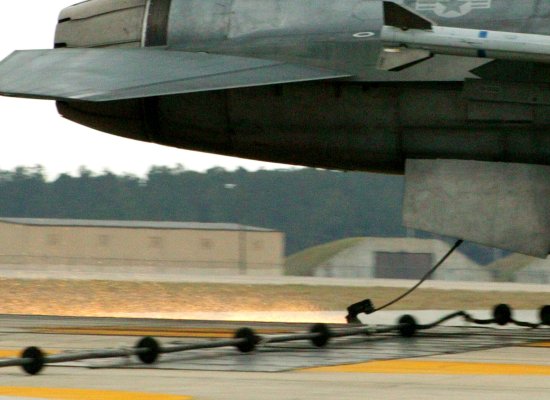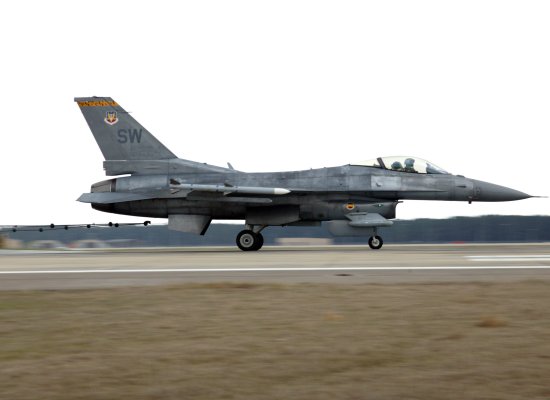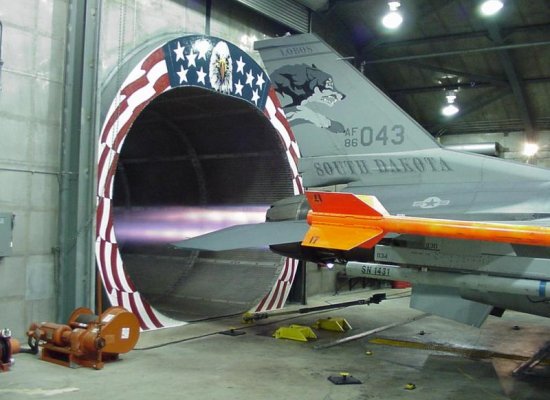|
||||||||||
|
|
||||||||||
|
||||||||||
|
|
||||||||||

The reason these Air Force planes are fitted with a tailhook is not so that they can land on an aircraft carrier. The hooks are instead used during emergency landings when the aircraft's brakes have failed or it has suffered structural damage that may make it difficult to keep the nose pointed down the runway during landing. The tailhook is also used during aborted takeoffs if there is any concern that the plane cannot stop on the length of runway remaining. Most runways at Air Force and other military bases, as well as some civilian fields, are equipped with crash barriers towards the end of the runway or sometimes in the middle. These barriers usually consist of thick cables similar to those used on Navy aircraft carriers.
The barriers are typically kept flush with or recessed into the runway surface until needed to keep the runway smooth for normal flight operations. Should the barriers be needed, the pilot will usually call "cable, cable, cable" instructing the airfield to raise the barriers into position for an emergency landing. Unlike Navy aircraft that can lower the hook in the air, Air Force aircraft can only do so while the plane is on the ground since the runway surface is the only positive stop to prevent the hook from swinging too far forward.

Tension is applied to the crash barrier cables using a number of methods. Low-tech solutions include attaching heavy chains or other dense objects to the ends of the cables that drag behind the aircraft to slow it down. More sophisticated techniques include water pistons or even using brakes from large aircraft like the B-52 to put tension into the cable.
The tailhook is held in place on the underside of the aircraft by a safety pin. Once the pilot depresses a button in the cockpit to deploy the hook, a pressurized pneumatic system forces it downward to disengage the pin and push against the airflow rushing past the aircraft. The pneumatic pressure pushing the hook down is balanced by a spring that pulls it upward and holds the hook about six to ten inches (15 to 25 cm) above the ground. This height is ideal for catching the cable while preventing the tailhook from bouncing back upward and missing the crash barrier.

Thanks to the tailhook and arresting system, pilots are able to stop their aircraft under conditions when they may not be able to do so otherwise. Landing conditions that may require a tailhook landing include hydraulic failure, other mechanical problems with the braking system, or a forced emergency landing on a short runway. The tailhook may also be used during an aborted takeoff. If the plane is at high enough speed and far enough down the runway, it may have insufficient braking power to come to a stop in the remaining runway space. Lowering the tailhook and calling for the cables allows the pilot to slow the plane and save it from running off the end of the runway.
Landing or takeoff emergencies requiring the tailhook are generally rare, but perhaps a more common use for the tailhook is during routine engine testing on the ground. Many Air Force bases feature facilities called hush houses and trim pads where planes are tied down to the ground while the engine is throttled up for post-maintenance checks. The tailhook is often used to secure the aircraft to the ground and prevent its motion during these high power tests.

It is a common misconception that the tailhook could allow an Air Force plane like the F-15 or F-16 to make a
landing aboard an aircraft carrier, even if only under emergency conditions. However, this is not possible since
the landing gear of these aircraft are simply not strong enough to survive the intense forces of a carrier
landing. Such an attempt would likely cause the gear to collapse or at least do considerable structural damage to
the plane requiring extensive inspection and repair.
- answer by Joe Yoon, 25 February 2007
Related Topics:
Read More Articles:


|
Aircraft | Design | Ask Us | Shop | Search |

|
|
| About Us | Contact Us | Copyright © 1997- | |||
|
|
|||